Round balers have come a long way from the Allis Chalmers machines that made miniature rounds bales. I am not old enough to remember these machines, but sadly I am old enough to remember the old Farmhand round balers of the late 1970s and early 1980s.
Today, there are two distinct types of round baler, fixed chamber or variable chamber. The design and function basic principles are loosely the same in either grouping regardless of manufacture.
Or that was the case until recently when John Deere introduced its new variable chamber 960 baler. It lacks what we would regard as a conventional tailgate; instead, a curtain hides a cleverly designed and integrated non-tailgate. Available in chopper and non-chopper variants, and with either 13 or 25 knives, the John Deere 960 is an interesting departure from the ‘traditional’ baler design.
I saw it for the first time at the British Grassland event in 2011. Being very ‘traditional’ in my views on baler design, I have to admit that while I was curious about the 960, I thought the marketing dept had been let loose in the Deere design dept and was not ‘convinced’ by what I saw. But all that changed this summer.
Courtesy of TFM Ltd, the Irish Farmers Journal got its hands on one, a JD 960 MaxiCut HC13, just at the end of the harvest and we gave it a good workout in both straw and hay. It’s a curious machine with a curtain to the rear masking the machines workings until it is time to eject a bale. It features the firm’s Fast Release System which incorporates bale chamber sides, movable sides and the rear curtain lifts with the tailgate to allow the bale toescape.
Getting to work
I collected the 960 baler and John Deere 6930 tractor which TFM had kindly paired and not quite sure what to expect, set off to bale some barley straw. Barley straw is the easiest to bale and less likely to give any hassle if there were problems. Kevin Doyle from TFM’s Enniscorthy branch guided me through the set up and then it was off to work.
The baler has two fibreglass wings on either side covering and protecting the baler’s workings. Our test machine was fitted with 500/55-20 Vredestein tyres and measured nine foot exactly to the outside of each tyre.
Weight wise, the operators manual quoted a figure of 4.44 tonnes depending on specification. It’s a baler with some definite presence.
Once in the barley straw it soon became apparent that this was no ordinary baler. The pick-up and intake resembles the Kuhn unit. We were baling behind a 16ft combine header in heavy straw conditions. Crop intake was exceptional, literally as fast as you could drive the tractor.
Over 18km/h it just got too uncomfortable to sit in the tractor. I did bring it up to 22km/h at one stage and it still took the crop in. The rest of my baling was carried out at around 14km/h which was comfortable for both man and machine.
When the bale was close to reaching the pre-determined size you got a warning beep. When it reached the size the beep was continuous and the net applied 1.5 seconds later (in automatic). The net roll was mounted at the front of the machine above the pick-up where it was visible to the tractor driver. Even in very dusty conditions baling the oaten straw, you could still see if the net was being applied.
In total, we made 400 bales of barley straw, oat straw and hay. I don’t believe there was a single netting error by the JD 960, several by the operator though. A couple of times where I had a doubt about the net application (rightly or wrongly), you could apply the net again without having to leave the tractor seat and re-set the net knife. This was done automatically in the net tying process.
There was an odd furry-ended bale but this was due to the operator (me) not making the bale properly. With a belt baler you have to drive properly and fill each side of the bale to make a good bale.
With a fixed chamber baler you will get away with this to some extent, but not with a belt baler. Some weave and some drive a set distance to the left and right of the row to fill the bale and make a proper shape.
Deere’s GreenStar 1800 display and control terminal has two black columns representing the left and right sides of the bale forming in the chamber. These provide a useful visual guide to bale formation and where to drive, but once you get into a rhythm you rarely look at it. Deere’s terminal I found was great at indicating but not very good at facilitating.
By this I mean that the column display is excellent, it shows bale diameter progress, target diameter, bale count tailgate open/closed and essentially all features and functions that the operator might need to operate the machine. Navigating the GreenStar 1800’s various menus to change baler settings or functions such as bale diameter, operate drop floor or change field/customer for bale count was just not easy enough or intuitive enough. I did manage every time but I was like a three year old with the remote control of the telly, just keep pressing buttons ‘till you get what you want.
On the plus side, it was very informative if something was not right, such as not closing the tailgate properly, or a bale not cleared the ejection ramp. In this instance it was very quick and easy to overcome the fault and carry on baling just by ‘OK-ing’ the fault and of course checking to see what caused it for example in the case of the bale holding the ejection ramp down.
All of the crops we baled were dry crops so we used the ‘Soft Core’ facility to make softer centres in what is essentially a hard centre baler. The Soft Core function deactivates the belt tension until a set diameter is reached and allows ‘dry’ bales such as straw and hay to breathe better. Our baler was set to 60% of the bale diameter and seemed to work well so we didn’t change it.
The JD 960 was incredibly fast and efficient at taking the crop, regardless of whether it was barley straw, oaten straw or hay. We never managed to block the baler so as to get an opportunity to use the drop floor. We came close once, re-baling a bale I made a mess of but the pto overload clutch went off twice before carrying on its consumption of straw.
In the bale chamber, there are two rollers above the rotor and one directly behind it and all help get the ball rolling literally. The net is fed in between the two upper rollers when it comes time to tie.
The larger roller does most of the work in terms of getting the ball rolling and feeding material into the forming bale. This roller also features a one way clutch so that as soon as the bale does start rolling and forming within the belts, it can’t, in any way, hinder the crop entering the chamber.
With the bale netted, ejection was incredibly fast and this is really what sets the baler apart from the rest of the pack. Literally, as fast as you can operate the tailgate lever the bale is ejected and it’s time to carry on baling. This does take a while to get your head around; more than once I checked to see if the bale was actually out.
Deere’s 960 baler does not feature a ‘traditional’ tailgate like that which we’ve been used to up until now. In fact, the firm separates the bale forming and bale chamber elements in its design. All the belt bale forming elements are incorporated into a separate external frame, including a much smaller, skeletal-like, lightweight tailgate. The bale chamber element is separate, literally just side plates which are hinged at the front.
This design allows the smaller and lighter tailgate to move incredible fast while maintaining belt tension which assists in the high speed ejection of the bale without damaging it. The sides of the bale chamber are kept rigidly in place by small rollers between the tailgate and sides. These rollers run up on small ramps to compress the sides on closing and, when ejecting the bale, allowing the sides to hinge out and release their side grip on the bale.
The Deere Fast Release System works absolutely brilliantly; the bale is ejected super-fast and without damaging it. We tried to time it but found it difficult to do accurately, but a conservative estimate attached to the John Deere 6930 tractor was barely over a second from full open to closed, ejecting the bale in the process.
The rear curtain is also raised by the tailgate on bale ejection and provides both cosmetic and functional guarding from the tailgate.
In oaten straw on a long 16 foot cut at 14km/h we made a bale, start to finish every 30 seconds. In a heavier crop of straw, hay or silage, this could no doubt be cut considerably. And being a hard-centre baler should consistently produce a good quality bale.
Maintenance
Our John Deere 960 baler was equipped with both an automatic chain oiler and an automatic greaser. There were few other points to grease with the main one being the pto.
This has a cover that could be unclipped at the baler end to gain access for greasing but the tractor end with wide-angle joint required a bit more ‘persistence’ to grease all its points.
Deere has provided excellent access to the knife with removable covers on both sides that need to be removed for sharpening. Most of the speed sensors on the baler feature a light which illuminates when ‘seeing’ metal and are very useful for fault finding if a problem occurs.
Summary
The John Deere 960 was an incredible baler to use; it was very fast both at the front end (pickup) and the back end (bale ejection), and consistently churned out good bales providing the operator didn’t make any errors.
My complaints were small and relate to navigating the control terminal and attaching the pick-up wheels and loading the net. The latter two are common, not just to Deere though, and would be a good project for a transition year student or Tullamore Show inventor to get stuck into, particularly handling of the net roll.
The John Deere 960 baler deserves a full thumbs up. One word of caution though, the real test of longevity for the 960 will be Irish operating conditions of heavy grass, high bale count and rough roads. Well may she wear.
960 facts
There are three versions of the John Deere 960 variable chamber baler: JD 960 RotoFlow HC - non-chopper baler, JD 960 MaxiCut HC13 – 13 knives 80mm theoretical chop length and JD 960 MaxiCut HC25 – selectable knife bank 12/13/25 knives with theoretical chop length of 40mm or 80mm.










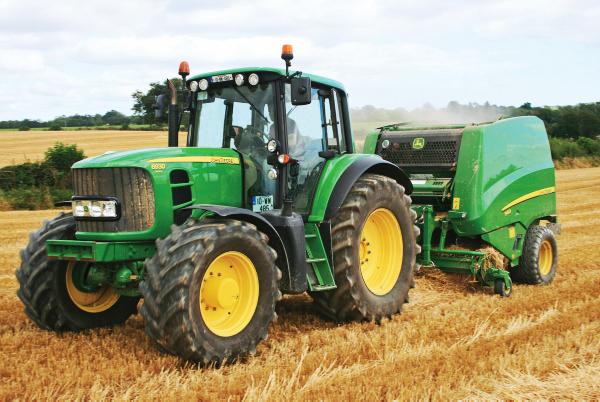
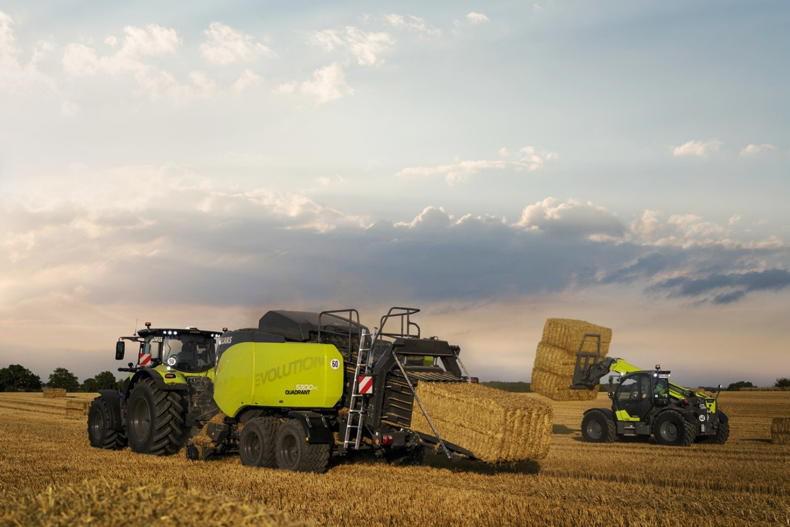

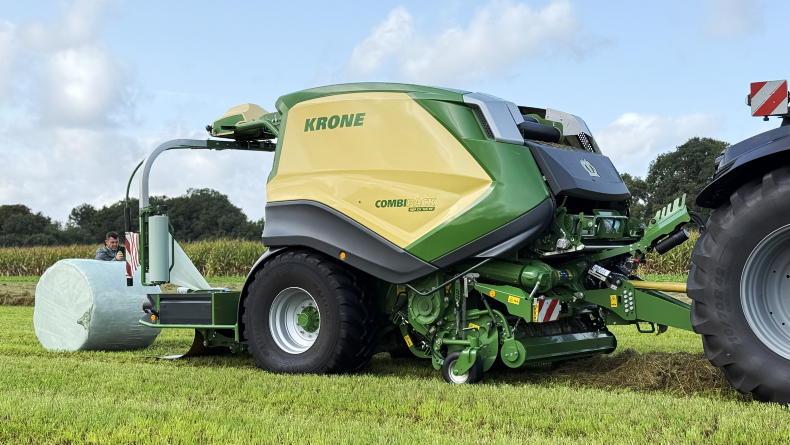
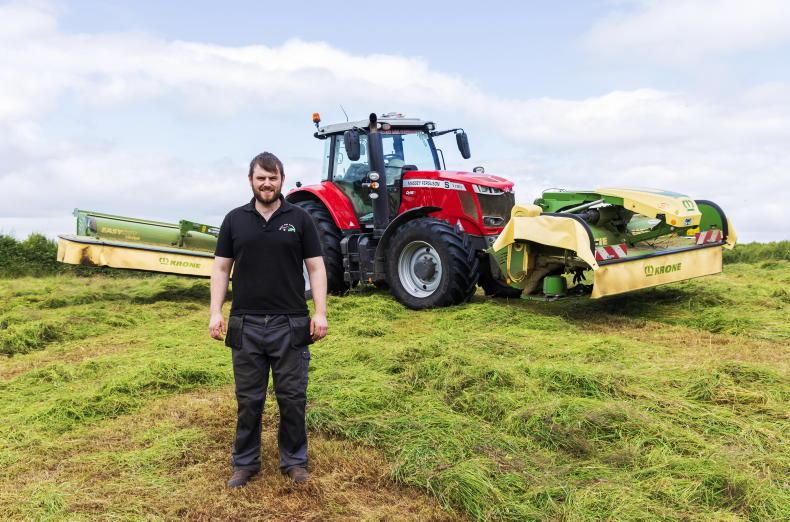
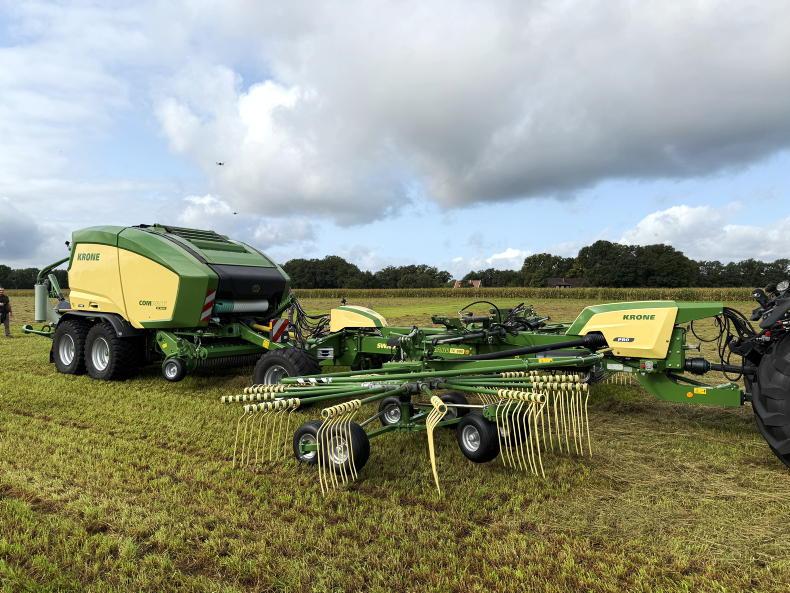
SHARING OPTIONS